
* One of the most peculiar dead ends of aircraft history was the rocket-propelled fighter aircraft. Such machines were built during World War II by a number of combatants, and the Germans actually put one design, the Messerschmitt Me 163 Komet, into combat operation. It was not a success; the pure rocket fighter turned out to be a bad idea. This document describes the rise and fall of the rocket fighter.

* There was a good deal of tinkering with liquid-fuel rocket engines in the years leading up to World War II, and once such engines became more or less practical there was interest in using them to propel aircraft.
In 1940, the Soviets had flown a rocket-powered sailplane, and it was only a next step to try to develop a rocket-powered combat aircraft. In the spring of 1941 the Soviet Union began work on a rocket-propelled interceptor, the effort being directed by the Viktor Bolkhovitinov design bureau, with bureau engineers Alexander Bereznyak and Alexei Isayev running the design effort.

The "BI", as the project was designated -- not in honor of the team leaders, but for "blijnii istrebitel (short-range interceptor)" -- was of simple construction, with a fabric-skinned wood frame; plywood-skinned wooden-frame wings; a Dushkin-Isayev DI-A pressure-fed liquid fuel rocket motor burning nitric acid oxidizer with kerosene fuel, providing 10.8 kN (1,100 kgp / 2,425 lbf thrust); and retractable taildragger landing gear. It had low-mounted straight wings; a conventional tail assembly except for the addition of "finlets" on the end of the tailplane, and dorsal fin that doubled as a tailwheel mount; a "razorback" style canopy that slid back to open; and armament of twin 20-millimeter ShVAK cannon mounted in the top of the nose.
___________________________________________________________________
BOLKHOLVITINOV BI:
___________________________________________________________________
wingspan:
6.48 meters (21 feet 3 inches)
wing area:
7 sq_meters (75.35 sq_feet)
length:
6.4 meters (21 feet)
height:
2.06 meters (6 feet 9 inches)
empty weight:
790 kilograms (1,740 pounds)
loaded weight:
1,685 kilograms (3,710 pounds)
max speed at altitude:
900 KPH (560 MPH / 485 KT)
___________________________________________________________________
Glide tests began in the spring of 1942, after the German invasion of the USSR the previous summer, with the initial powered flight being performed by test pilot Grigori Bakhchivandzhi on 15 May 1942. Trials showed the machine to have a staggering rate of climb, three times greater than that of any Soviet piston fighter, and a high level speed -- though endurance was poor. Pilot reports indicated that the aircraft had benign handling, though it did land "hot".
A total of eight prototypes was built, a few being fitted with ski landing gear for winter trials. A batch of 50 production machines was ordered, and various improvements were considered: spherical fuel tanks to increase fuel capacity by 30%, cockpit armor, and wingtip-mounted ramjets to improve flight endurance. A prototype was actually built with the ramjets, but it never got out of wind tunnel tests.
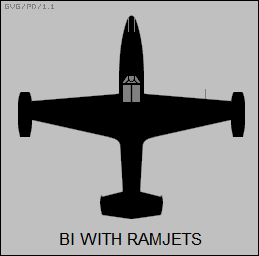
The BI never entered production. The program suffered a setback on 27 March 1943 when the third prototype nosed down at high speed, resulting in an uncontrolled dive into the ground and the death of the pilot, Bakhchivandzhi. The production batch was canceled, though flight tests continued into 1945, with the machine used basically as a high-speed test platform.
* During the same timeframe, the Soviets worked on a broadly similar aircraft, the "Kostikov 302", which was to use a Dushkin rocket engine and, at least as initially conceived, a ramjet engine under each wing. It got as far as glide tests, but rocket engine development problems led to the cancellation of the design program before powered flights. The design bureau of Nikolai Polikarpov, the "king of fighters", also worked on a rocket fighter, the "Malyutka", but it was unfinished when Polikarpov died of cancer in 1944; work on the machine ended with him.
BACK_TO_TOP* While the Soviets were working on the BI, the Germans were also working on rocket fighters, and in fact would take the concept into more or less operational service.
In 1935, work was begun at the Heinkel company on development of a demonstrator for a rocket-powered interceptor, the "He 176". The project was initiated in 1935, with the prototype rolled out for wind-tunnel tests in 1938. It had a cigar-shaped aircraft, with the pilot in a prone (lying on his belly) position, featured a conventional arrangement of flight surfaces, and was powered by a rocket engine built by the Hellmuth Walter company, with a maximum thrust of 4.9 kN (500 kgp / 225 lbf).
After performing some short hops off the runway, the He 176 performed its first flight on 20 June 1939, with FlugKapitan Erich Warsitz at the controls. The flight was performed in front of senior officials of the ReichsLuftMinisterium (RLM / German Air Ministry), including its boss, General Ernst Udet. They were not impressed: the machine was underpowered, performance was very poor, and the contraption seemed unsafe. Udet ordered test flights to cease. There was some vacillation over the order and a few more test flights were conducted, but in September 1939 the order came down to kill the He 176 project for good. The aircraft ended up in the air museum in Berlin, to be destroyed in a bombing raid in 1944. Details of the He 176 program remain unclear, and in fact only one photograph survives of the machine.
* Although the He 176 program was a fizzle, the notion of a rocket fighter did not die out. From the late 1920s, Dr. Alexander M. Lippisch had been working on tailless gliders at the "Deustchen ForschungsInstitute fuer Segelflug (German Research Institute For Sailplanes)". By 1939, Lippisch had advanced to the "DFS 40" glider, which had a short fuselage, relatively long wings, and a tailfin but no tailplane.
Lippisch had also worked with Heinkel on the He 176 program, but he moved to the Messerschmitt firm just before the outbreak of war in September 1939. At Messerschmitt, working under "Project X", Lippisch came up with a design for a powered derivative of the DFS 40, the "DFS 194". It was originally supposed to be fitted with a piston engine driving a pusher propeller, but in January 1940 a decision was made to fit it with a Walter RI 203 rocket engine.
Test flights of the rocket-powered DFS 194 were performed later in 1940, with the machine attaining 550 KPH (340 MPH), with a snappy rate of climb -- not bad for a crude demonstrator aircraft. Official interest in rocket fighters had been mild at best to that time, but suddenly it ramped up. The RLM authorized development of a scaled-up and more powerful follow-on for combat service, to be designated the "Me 163 Komet".
* The first of six unarmed prototypes, the "Me 163A V1" (where "V" stood for "versuchs / prototype") performed its initial unpowered flight in the spring of 1941, being towed into the sky by a Messerschmitt Bf 110 twin-engine fighter. The pilot of the Me163V1 was Heini Dittmar, a well-known glider pilot, who had test-flown all of Lippisch's earlier aircraft. Test flights using rocket propulsion began in September 1941. The engine was a Walter RII 203, which could be throttled from about 1.47 kN (150 kgp / 330 lbf) to 7.34 kN (750 kgp / 1,650 lbf) thrust. It was what was called a "cold" engine, powered by concentrated hydrogen peroxide ("T-Stoff") mixed with a liquid catalyst (calcium permanganate solution or "Z-stoff") that converted the hydrogen peroxide to hot steam.
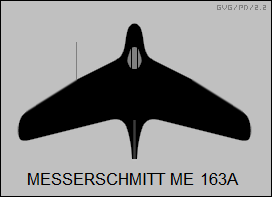
The fuel mix was toxic, corrosive, and prone to uncontrolled explosions, but the prototype's performance was astounding by the standards of the time. On 2 October 1941, Dittmar was towed aloft and lit the rocket engine after release, to then accelerate to 1,004 KPH (624 MPH) in level flight until the aircraft got such a bad case of the shakes that Dittmar had to let off the throttle. It broke all existing flight speed records by a large margin, though of course the project was a deep secret, and the matter wasn't publicized. Enthused, the RLM authorized prototype production of the "Me 163B" interceptor variant.
Lippisch left Messerschmitt in 1942, but the company went on with the project, building ten "Me 163A" glider trainers and 70 "Me 163B-0" development aircraft. The Me 163B-0 was in trials by the summer of 1942.
* The Me 163B-0 was powered by a Walter 109-509A rocket motor, powered by hydrogen peroxide / T-Stoff oxidizer and a fuel mixture consisting of hydrazine hydrate, methanol, and water known as "C-Stoff", which had been judged (somewhat) less troublesome than Z-stoff, and also did not leave behind a telltale white trail. The pilot operated the engine with a five-position throttle. The new engine was almost nasty as the earlier propulsion scheme, with toxic and corrosive propellants, plus an inclination to blow up. The engine had a tendency to flame out when the Me 163 reached the top of its climb and descended for attack, and took some work to restart.
The Me 163B, like the Me 163A, also didn't have proper landing gear: it took off on a two-wheel dolly that was discarded after takeoff, and landed on a pop-out skid and a semi-retractable tailwheel. The narrow track of the dolly and the lack of much aerodynamic control at low speeds made take-offs hazardous, particularly in crosswinds, and the dolly could bounce back up from the ground after release, making it a hazard; sometimes it wouldn't release, making landings so potentially difficult that the wisest thing to do was simply gain altitude and bail out.
It was also only too easy to roll the Me 163 on touchdown. Of course, there was no way a pilot could come around for a second approach if he blew it the first time, all the more so because he would generally dump whatever fuel he had remaining before coming in, since the toxic, corrosive, and explosive propellants would be a menace on a crackup.
The Me-16B's fuselage was heavily redesigned from that of the Me 163A to provide more fuel capacity. The swept wings featured ailerons, single-piece flaps, and a fixed slot on the outer wing leading edge. Handling was very pleasant, at least once the thing was in the air and moving along at speed, and performance under power breathtaking. Despite the Me 163's resemblance to a boomerang, it was said to be almost "spin-proof".
The Me 163B-0 was armed with twin MG 151/20 20-millimeter cannon, one in each wing root, with the weapons aimed by a Revi 16B gunsight. The pilot sat under a canopy that hinged open to the right. There was no cabin pressurization or heating and the pilot did not have an ejection seat, but he was given a fair amount of protective armor.

* By that time, it might have seemed that the Me 163 was a bad idea or at least one that wasn't "ready for prime time", but since the Reich was suffering from increasingly painful Allied bombing raids, the Luftwaffe began work on fielding the type. An evaluation unit, Erprobungskommando 16 (EK16) was established in February 1943 at the Luftwaffe Peenemuende-East installation in the Baltic, with the commander of EK16, Hauptman Wolfgang Spaete, coming up with a scheme to base Me 163s about 150 kilometers (95 miles) apart to allow them take on Allied bomber streams coming or going.
Things didn't go much better with the Me 163 from that time on, however, and all Me 163 operations were finally concentrated at Brandis airfield near Leipzig. EK16 moved to Brandis and helped set up the only operational squadron, JG 400. JG 400 received production "Me 163B-1a" machines, differing from the Me 163B-0 series by replacing the two 20-millimeter cannon with twin short-barreled MK 108 30-millimeter cannon and 120 rounds per gun. The production aircraft were built by a dispersed manufacturing organization -- originally under the direction of the Klemm company, and then under Junkers.
___________________________________________________________________
MESSERSCHMITT ME 163B-1A:
___________________________________________________________________
wingspan:
9.40 meters (30 feet 7 inches)
wing area:
18.5 sq_meters (199 sq_feet)
length:
5.85 meters (19 feet 2 inches)
height (on dolly):
2.76 meters (9 feet)
empty weight:
1,900 kilograms (4,190 pounds)
takeoff weight:
4,310 kilograms (9,500 pounds)
max speed at altitude:
960 KPH (600 MPH / 520 KT)
service ceiling:
12,000 meters (39,370 feet)
powered endurance:
7 minutes 30 seconds (typical)
___________________________________________________________________
The Komet was performing combat flights by mid-1944. Allied fighters first encountered the type on 28 July 1944, and on 16 August a P-51 shot one down. Combat revealed further weaknesses of the type. The Me 163 was very fast, shockingly fast for the time, but the high speed meant that it was difficult for a Komet pilot to score many hits during a pass on an Allied bomber. The fact that the MK 108 cannon tended to jam on occasion only made matters worse. The Me 163 also only had a powered endurance of about six minutes at full throttle, and it was effectively defenseless while it glided in for a landing. Since it lacked landing gear, it was immobilized after landing until it could be hauled off by a tractor, making it easy prey for Allied fighter-bombers skulking around its landing field. Still, Me 163s managed to obtain a few kills of their own.

* A few tandem-seat "Me 163S" glider trainers were built, with the fuel tanks removed to accommodate a second cockpit and water used for ballast. Experiments were performed with two Me 163Bs fitted with an improved Walter 109-509C rocket engine that featured a second thrust chamber for sustained, low thrust operation. There were plans for a "Me 163C" with the two-chamber engine, a bubble canopy for better visibility, more fuel in a stretched fuselage, cannon relocated from the wing roots to the nose, and a pressurized cockpit; three were built but never flew.
One Me 163A was fitted to carry twelve R4M folding-fin rockets on underwing racks. A particular whizzy scheme was considered, in which an Me 163B was fitted with the SG 500 "Jagdfaust (Fighter Fist)" armament array, consisting of ten fixed upward-firing recoilless firing tubes, each loaded with a single 50-millimeter projectile, with a counterweight blasted out of the bottom of the tube to cancel recoil on firing. The array of tubes was armed by the pilot on approach to a target bomber; as he flew underneath the bomber, a photoelectric cell fired the tubes into the aircraft's belly. Twelve Me 163Bs were modified with the Jagdfaust system, and at least one kill was scored using it.
Several hundred Me 163s were built up to the end of production in February 1945. Further work on the Me 163 was curtailed by the German surrender in May 1945. Examples of the Me 163 fell into Allied hands and were evaluated. However, by that time the deficiencies of the whole rocket fighter concept were too apparent. Evaluations were completed, reports filed, and the Me 163s were scrapped or consigned to museums. One now resides at the USAF Museum in Dayton, Ohio.
* In late 1943, the Japanese signed an agreement with the Germans to build the Me 163 under license, but the submarine carrying the plans was lost, and the only data the Japanese obtained on the aircraft was that which had been personally brought back by an Imperial Japanese Navy (IJN) officer. By July 1944, US B-29 Superfortress raids over Japan were becoming a threat, with the bombers flying too high for most aircraft to reach, and so the IJN assigned Mitsubishi to develop an Me 163 clone, using such data as was available. Unusually, given the extreme level of interservice rivalry between the IJN and the Imperial Japanese Army (IJA), the development program was established as a collaboration between the two services.
A team under Takahashi Mijiro of Mitsubishi moved rapidly on development, with a detailed mockup of the "Shusui (Sword Stroke)" -- with the IJN designation of "J8M1" and the IJA designation of "Ki-200" -- available for inspection by September 1944. In the meantime, the First Naval Air Technical Arsenal in Yokosuka was working on a glider to validate the Shusui's aerodynamics. The first "MXY8 Akigusa (Autumn Grass)" glider performed its initial flight on 8 December 1944, with the aircraft towed into sky, and piloted by IJN Lieutenant Commander Inuzuka Toyohiko.
Trials went well and two more glider prototypes were built at Yokosuka, one being handed on to the IJA. The IJN then initiated work on a revised version of the MXY8 for training, with water ballast tanks to approximate the weight of the Shusui. Production of the IJN towed training glider was farmed out to the Maeda Aircraft Institute, and production of the IJA training glider (as the "Ku-13") was assigned to the Yokoi Aircraft Company. At least 50 of the training gliders were built; the Navy wanted to develop a self-propelled trainer, the "MXY9 Shuka (Autumn Fire)", with ducted fan propulsion, but it never happened.
Mitsubishi built two Shusuis with ballast replacing fuel tanks and engine for towed glide tests, with the first performing its initial flight on 8 January 1945. The aircraft looked so much like its Me 163 parent as to be hard to tell apart, though it did have slightly different details and lines, particularly a pointier nose. The first powered Shusui performed its initial flight on 7 July 1945, with the rocket engine cutting out just after takeoff and the aircraft crashing back into the ground; Lieutenant Commander Inuzuka was killed. A little over a month later, Japan surrendered. Six more Shusui prototypes had been completed or were in advanced stages of construction at the time, but they never flew.
Mitsubishi, Nissan, and Fuji were in preparations for production at the time. The operational J8M1 / Ki-200 was to be armed with twin 30-millimeter Type 5 cannon, while the IJN wanted to develop a "J8M2 Shusui-Kai" in which one of the cannon was deleted in favor of more fuel tankage. The IJA preferred to keep the two cannon, instead focusing on the enlarged "Ki-202" with more fuel tankage. None of it ever happened. Given the circumstances of Japanese industry at the time, it is surprising the Shusui program got as far as it actually did. It doesn't appear any examples have survived.
BACK_TO_TOP* Along with the Me 163, the Reich also developed an interesting vertically-launched, expendable rocket-propelled interceptor, the Bachem "Natter (Viper)", The famed German rocket scientist Wernher von Braun had described a rocket interceptor that would be launched straight up in a memo written for the RLM in July 1939. There was no requirement for such a weapon at the time, but Dr. Erich Bachem of the Fieseler company thought it was an idea with merit, and drew up a series of designs based on the concept.
In the spring of 1944, when the situation for the Reich was clearly becoming desperate, the RLM issued a requirement for a small and cheap interceptor, built mainly of wood and intended for defense of point targets. Junkers, Heinkel, and Messerschmitt submitted proposals; the RLM selected the Junkers P1077 "Julia" rocket-powered interceptor as the winner. It was a little machine, with stubby straight wings and a twin-fin tail, designed to be launched vertically from a gantry using solid-rocket boosters. The pilot rode in a prone position; the machine was powered by a Walter 109-509C rocket engine, was armed with twin MG 151/20 20-millimeter cannon, and would land with skids.
Bachem submitted a proposal, even though he hadn't been included in the competition. To no surprise the RLM ignored his submission, but he then managed to get support for his design, the "BP 20 Natter", from Reischfuehrer Heinrich Himmler, leader of the SS. Himmler liked to get involved with high-priority projects to promote himself and the SS; Himmler ordered 150 Natters built with SS funding, the Luftwaffe then ordering 50 more. The aircraft was given the service designation of "Ba 349". Although there were protests from officials of the aeronautical establishment, they were outranked, and work on the Julia was derailed, though not halted. Junkers did manage to get two prototypes to a state of near-completion, but they never flew.
Bachem began detailed design work on the Natter in August 1944 at a small factory at Waldsee in the Black Forest. The machine that emerged was a tubby little aircraft, built almost entirely of wood except for engine, fittings, control pushrods, and the like. It had short stubby straight wings and cruciform tailfins. All the flight surfaces were flat, no anhedral or dihedral; there were no flight control surfaces on the wings, all the flight control surfaces being relegated to the tailfins.
The Natter was blasted straight up into the sky on a gantry tower. The tower tilted flat to be loaded up with an aircraft and then raised to vertical for launch. The Natter was powered by a Walter 109-509A-2 rocket motor, much the same engine as used in the production Me 163s and burning T-Stoff / C-Stoff, but modified for vertical operation. To get the machine off the ground, the Natter also had four solid-rocket boosters that produced 19.6 kN (2,000 kgp / 4,400 lbf) thrust for ten seconds, and were then discarded.
On initial boost, the flight control surfaces were locked; once the solid-rocket boosters were discarded, the aircraft was guided under a radio-controlled autopilot towards the target, which was being tracked by radar at the ground control station. The pilot could take control at any time. Flight controls were very simple. The pilot was given some cockpit armor for protection.
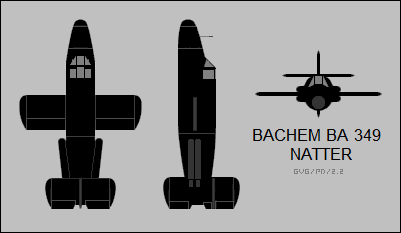
Armament consisted of a battery of unguided rockets in the nose, possible configurations consisting of either 33 R4M 55-millimeter folding-fin rockets, or 24 Foehn 73-millimeter spin-stabilized rockets, with the nose covered by a hemispherical plastic cap before firing. The pilot would perform the terminal attack, aiming with a simple ring sight in front of the cockpit and firing all his rockets in a single salvo. Once the rockets were expended, the pilot had to get back down to earth, which was the tricky part. The Natter had no landing gear; it popped out a tail parachute and the front part of the fuselage fell off, allowing the pilot to parachute to safety. The rear fuselage was recovered so that components, particularly the rocket motor and the autopilot, could be salvaged for re-use in another airframe.
___________________________________________________________________
BACHEM BA 349 NATTER:
___________________________________________________________________
wingspan:
3.60 meters (11 feet 10 inches)
wing area:
2.75 sq_meters (29.6 sq_feet)
length:
6.10 meters (20 feet)
height:
2.25 meters (7 feet 4 inches)
empty weight:
1,095 kilograms (2,415 pounds)
loaded weight:
2,200 kilograms (4,800 pounds)
max speed at altitude:
800 KPH (500 MPH / 430 KT)
service ceiling:
14,000 meters (4,850 feet)
___________________________________________________________________
In short, the Natter was a piloted surface-to-air missile (SAM). In fact, in the original concept, the Natter was to have rammed a bomber after expending all rocket ammunition, with the pilot ejecting before impact -- but fitting an ejection seat proved difficult and too expensive, so the idea had been given up.
* Glide trials were performed with a ballasted airframe beginning in November 1944 to validate the Natter's aerodynamics and escape system. A Natter was hauled to altitude underneath a Heinkel He 111 bomber and released; the test pilot, a FlugKapitan Zeuber, reported that the Natter handled crisply, and he had no problems with the escape procedure.

The first vertical-launch test, using an unmanned Natter fitted only with the four solid-rocket boosters, was on 22 December 1944. Ten similar tests followed, and then the Natter was judged suitable for piloted tests. The first such test was on 28 February 1945, with Oberleutnant Lothar Siebert at the controls. It ended in tragedy; the Natter flew up into the sky, but the canopy broke off, and then the aircraft fell back to the ground, with Siebert still on board. Nobody had a real idea of what happened, but doublechecks were performed, and three more manned test flights were successfully flown to the end of March.
Now it was time to see if the Natter could be used in combat. An evaluation unit was formed at Kircheim near Stuttgart, with ten launchers erected in early April and the pilots standing by for their chance to take a crack at Allied bombers. However, American tanks arrived before bombers did, and the aircraft and launchers were destroyed to prevent them from falling into enemy hands. A total of 36 Natter airframes was built, including all the test prototypes, with three falling into American hands and one into Soviet hands. It doesn't appear, probably fortunately, that any of these four machines were flown.
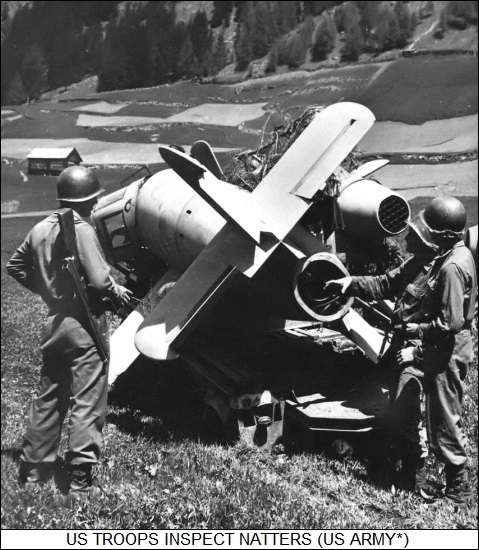
Three of the 36 were production-spec "BP 20B" or "Ba 349B" machines, which looked much like the initial-spec Ba 349 Natter but had a Walter 109-509C engine with the second cruise thrust chamber, extending burn endurance from 2 minutes 15 seconds to 4 minutes 30 seconds. The four booster rockets were repositioned to deal with changes in the Natter's center of gravity; larger booster rockets were also to have been fitted, but these bigger rockets were never actually delivered.
* In hindsight, the Natter had a few things going for it on paper. The vertical launch scheme meant that launch sites could be widely distributed and easily concealed, and landing wasn't a problem, as such. Whether a manned SAM would have proven effective is another question -- but fortunately for the Allies, the Reich ran out of time before that question could be answered. The victors went on to develop true SAMs and had no reason to investigate the concept of a manned SAM any further. At least three Natters survive as museum exhibits, and replicas have been built as well -- any reasonable carpentry shop could put one together.
BACK_TO_TOP* As a follow-on to the Me 163C, in 1944 the Messerschmitt company began work on a further improved version, the "Me 163D", with retractable tricycle landing gear and other improvements. A prototype performed glide tests in mid-1944, but the RLM ordered the project passed on to Junkers at Dessau to free up Messerschmitt resources. At Junkers, a team under Professor Hertel made a number of improvements to the design, such as a more robust electrical-hydraulic system powered by a three-blade "windmill" on the aircraft's nose.
A single prototype of this refined design, originally designated the "Ju 248 V1", began towed gliding flights in August 1944; it was then redesignated "Me 263 V1" at the RLM's insistence. Frantic efforts to get the type into production proved an exercise in futility. The prototype was captured by the Red Army at the end of the war, to be carted off to the USSR.
___________________________________________________________________
MESSERSCHMITT ME 263:
___________________________________________________________________
wingspan:
9.50 meters (31 feet 2 inches)
wing area:
17.8 sq_meters (191.6 sq_feet)
length:
7.83 meters (25 feet 8 inches)
height:
3.17 meters (10 feet 5 inches)
empty weight:
1,920 kilograms (4,235 pounds)
loaded weight:
5,300 kilograms (11,685 pounds)
max speed at altitude:
880 KPH (550 MPH / 475 KT)
___________________________________________________________________
* The Me 263 was at least an influence in the design of a second Soviet rocket fighter, the Mikoyan-Gurevich (MiG) "izdeliye (product) 270" or "I-270". Soviet jet engine development had lagged that in the West, with the result that in the immediate postwar period the USSR's most powerful jet engines were copies of the German Junkers Jumo 004 and BMW 003 turbojets. Even they didn't provide very high levels of thrust, and so there was interest in developing an improved rocket-powered interceptor.
The MiG OKB submitted a design for such a rocket fighter in the spring of 1946. The MiG I-270 design had a fuselage like that of the Me 263, featuring a similar cockpit and landing gear arrangement, but the I-270 was substantially longer, and also had mid-mounted straight wings and a tee tail. Soviet engineers had little design data on swept wings, and were suspicious of the tailless configuration of the Me 163 / Me 263.
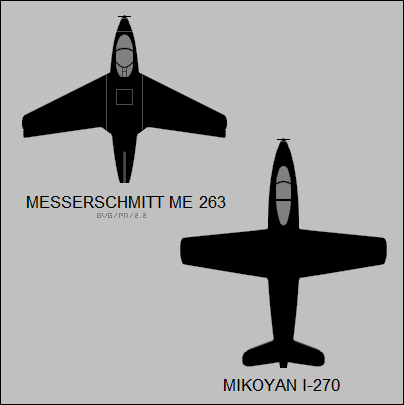
The powerplant was a Dushkin-Glushko RD-2M-3V liquid-fuel rocket burning nitric acid oxidizer and kerosene fuel. The RD-2M-3V had twin thrust chambers, one for boost and one for cruise, arranged one on top of the other. With both chambers burning, maximum thrust was 14.2 kN (1,450 kgp / 3,200 lbf); shutting off the top chamber and cruising on the lower chamber cut thrust to 3.9 kN (400 kgp / 880 lbf). A windmill-type electric generator in the nose provided power for the engine turbopumps and other electrical systems. The cockpit was pressurized, with the pilot sitting on an ejection seat, making the I-270 one of the first Soviet aircraft with such a feature. The proposed armament for the aircraft was twin NS-23 23-millimeter cannon with 40 rounds each, and eight rockets on underwing launch rails.
___________________________________________________________________
MIKOYAN I-270:
___________________________________________________________________
wingspan:
7.75 meters (25 feet 5 inches)
wing area:
12 sq_meters (129 sq_feet)
length:
8.92 meters (29 feet 4 inches)
height:
3.08 meters (10 feet)
empty weight:
1,545 kilograms (3,405 pounds)
loaded weight:
4,150 kilograms (9,150 pounds)
max speed at altitude:
1,000 KPH (620 MPH / 540 KT)
service ceiling:
17,000 meters (55,750 feet)
___________________________________________________________________
Two I-270 prototypes were built, the first being rolled out in late 1946. It was not fitted with a rocket engine, but gliding flights were performed beginning in December 1946, with the aircraft appropriately ballasted and towed up into the sky by a Tupolev Tu-2 twin-engine bomber. The second prototype did have a rocket engine, performing its initial flight in early 1947 with V.N. Yuganov at the controls. However, the second prototype suffered a bad landing and had to be written off, with the first prototype then suffering a similar fate. By that time, progress on jet fighters and SAMs had shown the I-270 to be a dead end, and the program was abandoned.
BACK_TO_TOP* Along with rocket fighters, the Germans also attempted to build a rocket-boosted high-altitude reconnaissance aircraft, the "Deutsches Forschunginstitut fuer Segelflug 228 (DFS 228)". The notion of an aircraft that could boost to very high altitudes under rocket power and then glide for extended periods of time was dreamt up in 1940, and in 1941 the RLM issued a preliminary request for such an aircraft to the DFS. The project ended up on the back burner for two years, and then was revived by the RLM in 1943.
The DFS 228 design that emerged was a sailplane with a torpedo-like body, featuring a wingspan of 17.6 meters (57 feet 8 inches) and a length of 10.6 meters (34 feet 8 inches). In operation, it was envisioned as carried on top of or towed behind another aircraft to an altitude of 10 kilometers (33,000 feet), where it was released to boost under rocket power to an operational altitude of almost 23 kilometers (75,000 feet). Once at that altitude, the DFS 228 then glided towards the target, occasionally reboosting itself to high altitude with a short burn of its rocket engine. It maintained high-altitude flight in this fashion for 45 minutes before fuel was exhausted, and then glided the rest of the way back to base. Range was expected to be 1,050 kilometers (650 miles) from release point.
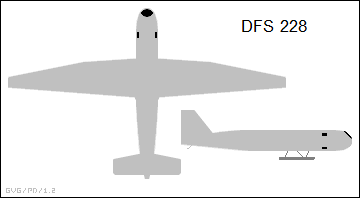
The DFS 228 was of mostly wooden construction, with a pressurized and insulated nose compartment for the pilot and cameras. The pilot lay prone and could see through a large plexiglas porthole in the nose and a small plexiglas window on each side. The plexiglas panels were made up of two layers and hot air was circulated between them to keep them from icing up. The nose compartment included a climate control system, and the pilot breathed pure oxygen.
Two Zeiss infra-red cameras were fitted, one below each side window. The DFS 228 was powered by a Walter HWK 109-509 liquid-fuel motor, burning T-stoff and C-stoff. The aircraft landed on a retractable metal skid. If the pilot had an emergency at high altitude, he could escape by blowing the nose compartment off; the nose compartment then deployed a parachute to stabilize it, and when it fell to an altitude where the pilot could survive exposure, automatically ejected him using a compressed air system.
The first unpowered DFS 228 V1 prototype was completed in 1943, to perform extensive gliding trials after being launched from the top of a Dornier Do 217K twin-engine bomber; a second prototype was also built and run through gliding trials. Powered flights were never conducted. Ten pre-production DFS 228A aircraft were under construction when the end of the war brought the project to a halt. The DFS also conducted studies for a follow-on aircraft, the "DFS 346", which was estimated to be capable of almost Mach 2 at operating altitude, but it was never any more than a "paper plane".
BACK_TO_TOP* The Americans also worked on a rocket fighter during the war, but the aircraft that finally emerged from the program, the Northrop "XP-79" flying wing, ended up being turbojet-powered, and is better discussed in a document on the Northrop flying wing family.
The Soviets actually built a good number of rocket aircraft after the conflict -- including some originally designed by the Germans and flown by the USSR -- but only the I-270 was armed, the other vehicles being strictly experimental research machines. In addition, during the 1950s, there was quite a bit of tinkering internationally with "mixed power" fighters that featured both rocket and jet propulsion -- in fact, the well-known French Dassault Mirage III fighter could be optionally fitted with a liquid-fuel booster rocket, but this was rarely if ever done on an operational basis. The mixed-power fighters of the 1950s were somewhat different beasts from the pure rocket fighters like the Me 163, and also deserve to be discussed in a separate document ... one of these days.
* In an interesting footnote to the Me 163 story, in the mid-1990s a German homebuilt aircraft enthusiast named Josef Kurz decided to construct a full-scale flying glider replica of the Me 163. He took the red-painted glider up into the air for the first time in 1996, to become a fairly well-recognized participant in German airshows. It's very authentic in appearance, the biggest exception being that he put a wheel in the landing skid; of course the glider was much lighter than a real Me 163, and didn't need robust landing gear. Kurz considered putting a small engine in the glider so he wouldn't need a tug plane to get airborne, but he never did, and ultimately sold the glider off. He described its handling as excellent, and videos of performances of the aircraft suggest it is, by glider standards, exciting to fly.
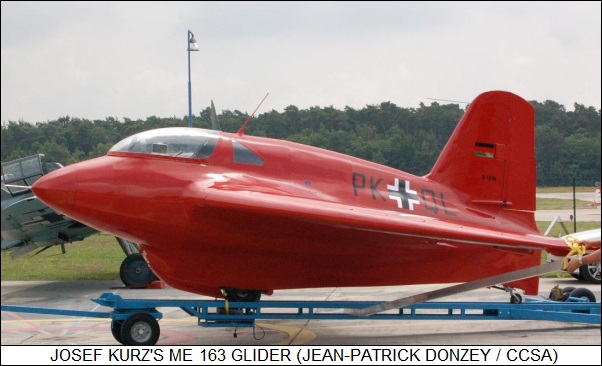
* Sources include:
Other useful information was obtained from the French "prototypes.com" website.
* Revision history:
v1.0.0 / 01 mar 06 v1.1.0 / 01 apr 07 / Review & polish. v1.1.1 / 01 mar 09 / Review & polish. v1.1.2 / 01 apr 10 / Added Josef Kurz's Me 163 glider. v1.1.3 / 01 mar 12 / Review & polish. v1.1.4 / 01 feb 14 / Review & polish. v1.1.5 / 01 jan 16 / Review & polish. v1.1.6 / 01 dec 17 / Review & polish. v1.1.7 / 01 nov 19 / Review & polish. v1.1.8 / 01 sep 21 / Review & polish. v1.1.9 / 01 aug 23 / Review & polish.BACK_TO_TOP
